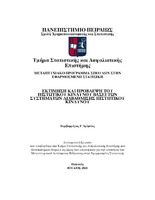Εκτίμηση και πρόβλεψη του πιστωτικού κινδύνου βάσει των συστημάτων διαβάθμισης πιστωτικού κινδύνου
Estimation and prediction of credit risk based on rating transition systems

View/
Keywords
KMV model ; Probability of default ; Merton's KMV ; Πιστωτικός κίνδυνος ; Απόσταση από αθέτηση ; MertonAbstract
Default risk is defined as the uncertainty surrounding the ability of a company or a natural person to fulfill their debts and obligations. In order to offset the lenders’ uncertainty, risk management in the financial sector is one of the most important research subjects in this field, performing a series of probabilistic assessments on the likelihood of default by using a series of models for the aforementioned predictions. The aim of the present paper is the analysis of the structure and basic parameters of credit risk in the context of Merton’s models. This paper studies bibliographically the basic concepts and parameters for application of the aforementioned models. Firstly, there is an analysis of the concepts of financial risk faced by institutions and businesses, the structure and function of credit risk, and the way of modelling it; this is followed by an analysis of Merton’s model in the advanced case of the KMV (Kealhofer, McQuown and Vasicek) model. Lastly, a trial of the model is implemented, using real data in order to examine the Default Possibility for various companies based on different financial circumstances.


